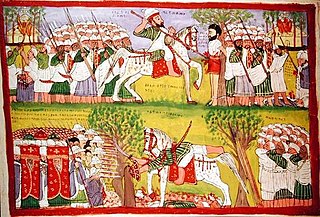Related Research Articles

Ahmad ibn Ibrahim al-Ghazi was the Imam of the Adal Sultanate from 1527 to 1543. Commonly named Ahmed Gragn in Amharic and Gurey in Somali, both meaning the left-handed, he led the invasion and conquest of Abyssinia from the Sultanate of Adal during the Ethiopian-Adal War. He is often referred to as the "King of Zeila" in medieval texts.

The Blue Nile Falls is a waterfall on the Blue Nile river in West Gojjam, Amhara Region, Ethiopia. It is known as Tis Abay in Amharic, meaning 'great smoke'. It is situated on the upper course of the river, about 30 kilometres (19 mi) downstream from the town of Bahir Dar and Lake Tana. The falls are one of Ethiopia's best-known tourist attractions.

Dawit II, also known by the macaronic name Wanag Segad, better known by his birth name Lebna Dengel, was Emperor of Ethiopia from 1508 to 1540, whose political center and palace was in Shewa.

Galawdewos, also known as Mar Gelawdewos, was Emperor of Ethiopia from 3 September 1540 until his death in 1559, and a member of the Solomonic dynasty. His throne name was Atsnaph Sagad I. A male line descendant of medieval Amhara kings, he was a younger son of Dawit II and Seble Wongel.
Na'od was Emperor of Ethiopia from 1494 to 31 July 1507, and a member of the Solomonic dynasty. His regnal name was Anbasa Bazar. His reign was marked by internal tension between territories with the assistance of Queen Eleni. He began construct an extravagant church in Amhara province, called Mekane Selassie. The church was completed by his successor Dawit II in 1530.

Menas or Minas, throne name Admas Sagad I, was Emperor of Ethiopia from 1559 until his death in 1563, and a member of the Solomonic dynasty. He was a brother of Gelawdewos and the son of Emperor Dawit II.

Susenyos I, also known as Susenyos the Catholic, was Emperor of Ethiopia from 1607 to 1632, and a member of the Solomonic dynasty. His throne names were Seltan Sagad and Malak Sagad III.
Mahfuz was a Harari Garad, Emir of Harar and Governor of Zeila in the Adal Sultanate. Although he was originally only emir of a small region he would rise to become leader of Adal due to his popularity, wielding more power than the sultan of Adal. He is often known as the "Captain of Zeila" in medieval texts.

Amba Geshen is the name of a mountain in northern Ethiopia. It is in Ambassel, South Wollo Zone of the Amhara Region, northwest of Dessie, at a latitude and a longitude of 11°31′N39°21′E. Part of Ambassel woreda, Amba Geshen is one of the mountains of Ethiopia where most of the male heirs to the Emperor of Ethiopia were interned, usually for life. Also known as Gishen Mariam, it was the second of the three such mountains, or amba, said to have been used for this purpose, the other two being Debre Damo and Wehni.
Hadiya also known as Adea or Hadia was a medieval Muslim state in the southern part of its realm located south of Shewa and west of Sharkha. The Hadiya Muslim state mainly composed of Cushitic Hadiyya proper, Halaba, Kebena people as well as Semitic Sil'te and other tongues related to Harari language. Hadiya was historically a vassal state of the Adal federation and then became an autonomous province of Abyssinia in the fourteenth century while still remaining a member of the Zeila union. In the 1600s Hadiya regained its independence and was led by a Garad. By 1850, Hadiya is placed north-west of lakes Zway and Langano but still between these areas.

The Battle of Wayna Daga was a large-scale battle between the Ethiopian forces and the Portuguese Empire and the forces of the Adal Sultanate and the Ottoman Empire in the east of Lake Tana in Ethiopia on 21 February 1543. The available sources give different dates for the battle. Led by the Emperor Galawdewos, the combined army of Ethiopian and Portuguese troops defeated the Adal-Ottoman army led by Imam Ahmad ibn Ibrahim al-Ghazi. Imam Ahmad was killed in the battle and his followers were utterly routed.
The Battle of Baçente was fought on February 2, 1542, when a Portuguese army under Cristóvão da Gama took a hillfort held by Adalite forces in northern Ethiopia. The Portuguese suffered minimal casualties, while the defenders were reportedly all killed.
The Battle of the Hill of the Jews was fought in Ethiopia in August 1542 between the Portuguese forces of Cristóvão da Gama and the Adal Sultanate. The Portuguese won the battle, capturing many horses that they could have used to exploit their victory in the previous battle of Jarte.
Yeshaq was the Bahr Negus during the mid to late 16th century. A subordinate of Ethiopian Emperor Dawit II, he was noted for supporting Gelawdewos during the Ethiopian-Adal war, and rebelling against his successors.

Cristóvão da Gama, anglicised as Christopher da Gama, was a Portuguese military commander who led a Portuguese army of 400 musketeers to assist Ethiopia that faced Islamic Jihad from the Adal Sultanate led by Imam Ahmad ibn Ibrahim al-Ghazi.
Sayint, also known as Amhara Sayint, is a district in the Amhara Region, Ethiopia. It is named after the historical district of Amhara Sayint which was located in the same area. Part of the South Wollo Zone, Sayint is bordered on the south by Debre Sina and Mehal Sayint, on the west by the Blue Nile that separates it from the East Gojjam Zone, on the northwest by the Bashilo River that separates it from the South Gondar Zone, on the north by Magdala, on the east by Tenta and on the southeast by Legambo. The major town in Amhara Sayint is Ajibar. Mehal Sayint was created by separating it from the historic Amhara Sayint woreda.
Dawaro or Doaro was a Muslim principality which laid near Hadiya. The state was originally independent until becoming a vassal and later a province due its subjugation by Emperor Amda Seyon I in the early 14th century. The region was situated east of Hadiya and north of Bali which covered much of Ethiopia's Arsi Province. The capital of Dawaro was called Sabboch
Bati del Wambara fl. 1531, was the Harari wife of the 16th-century general, Ahmad ibn Ibrahim, and then his successor, Nur ibn Mujahid. She was extremely influential in shaping both her husbands' military policies in their campaigns against the Ethiopian Empire.
Seble Wongel was Empress of Ethiopia through her marriage to Lebna Dengel. She is well-known as a key political and military figure during the Ethiopian–Adal War, as well as the reigns of her sons and grandson.

Fatagar was a historical province that separated Muslim and Christian dominions in the medieval Horn of Africa. In the eleventh century it was part of the Muslim states, then was invaded by the Christian kingdom led by Emperor Amda Seyon I, after which it would serve as central district in, and home of multiple rulers of, the Ethiopian Empire in the 15th century.
References
- ↑ C.F. Beckingham, "A Note on the topography of Ahmad Gragn's campaigns in 1542", Journal of Semitic Studies, 4 (1959), p. 370
- ↑ G.W.B. Huntingford locates Sard in Sahart (The historical geography of Ethiopia from the first century AD to 1704), (Oxford University Press: 1989), p. 134
- ↑ As paraphrased by James Bruce, Travels to Discover the Source of the Nile (1805 edition), vol. 3, pp. 202f
- ↑ C.F. Beckingham, "A Note on the topography of Ahmad Gragn's campaigns in 1542", Journal of Semitic Studies, 4 (1959), p. 370
- ↑ Beckingham, "A Note," p. 371